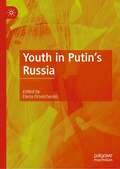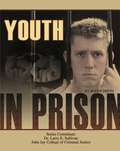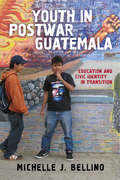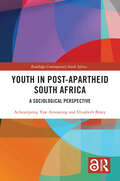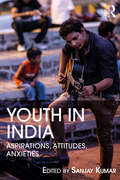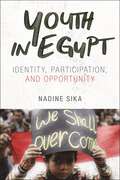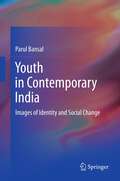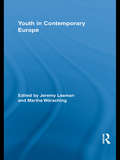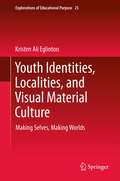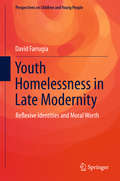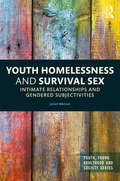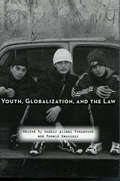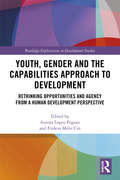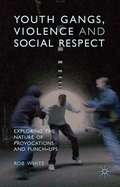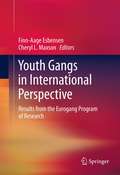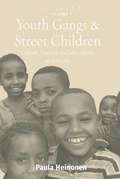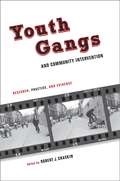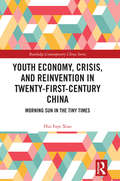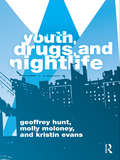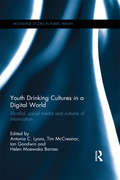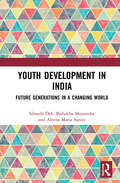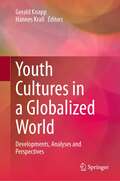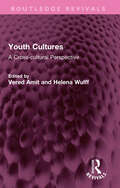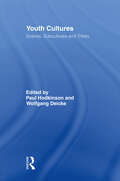- Table View
- List View
Youth in Putin's Russia
by Elena OmelchenkoThis edited volume sheds light on the lives of young people in various central and peripheral regions of Russia, including youth belonging to different ethnic and religious groups and who have differing views on contemporary politics. While the literature continues to grow regarding the inclusion of youth in global contexts, the specific cultural, political, and economic circumstances of being young in Russia make the Russian case unique. Chapter authors focus on four key aspects that characterize the youth experience in contemporary Russia: cultural practices and value affiliations, citizenship and patriotism, ethnic and religious diversity, and the labor market. This collection will appeal to readers interested in contemporary life in Russia and looking for the latest empirical material on youth identities and cultures, as well as those looking to learn about the critical viewpoint of local academics regarding the ongoing processes in contemporary Russian society.
Youth in Prison
by Roger SmithThe subject of juvenile detention is a major issue for Canadian and U.S. societies, and especially for teens. This book looks at juvenile detention: beginning with the environments that often produce troubled teens, to the legal process of the juvenile courts, to the varieties of detention arrangements and daily life in a juvenile detention facility. The book does not shy away from hard questions: are teen delinquents criminals, victims, or both? Should society punish or rehabilitate? The book offers multiple perspectives on difficult issues, considering both statistics and life stories. Youth in Prison is valuable reading for all concerned with juvenile crime, detention, and the future of troubled young people's lives.
Youth in Postwar Guatemala: Education and Civic Identity in Transition
by Michelle J. BellinoIn the aftermath of armed conflict, how do new generations of young people learn about peace, justice, and democracy? Michelle J. Bellino describes how, following Guatemala’s civil war, adolescents at four schools in urban and rural communities learn about their country’s history of authoritarianism and develop civic identities within a fragile postwar democracy. Through rich ethnographic accounts, Youth in Postwar Guatemala, traces youth experiences in schools, homes, and communities, to examine how knowledge and attitudes toward historical injustice traverse public and private spaces, as well as generations. Bellino documents the ways that young people critically examine injustice while shaping an evolving sense of themselves as civic actors. In a country still marked by the legacies of war and division, young people navigate between the perilous work of critiquing the flawed democracy they inherited, and safely waiting for the one they were promised.
Youth in Post-Apartheid South Africa: A Sociological Perspective (ISSN)
by Acheampong Yaw Amoateng Elizabeth BineyThis book investigates the life experiences of youth in South Africa, considering whether contemporary youth have benefitted from the socioeconomic reconstruction of post-apartheid society.Student protests against apartheid drove transformative change in South Africa, and the subsequent new constitution promised positive change for the nation’s youth across a range of sectors. Adopting a sociological perspective, this book uses primary and secondary data sources to illustrate the myriad ways post-apartheid socioeconomic developments have impacted the life experiences of the country’s youth across areas including health, education, family life, economic activity, technology, substance use, and politics. The book considers the historical legacy of colonialism, racism and immigration in shaping the context in which youth experiences in the country have evolved. The book argues that in 1976 South Africa’s youth became the conscience of the nation when they brought the apartheid regime to its knees during the Soweto uprising. What happens to them now will continue to define the nation’s future.This book will be of interest to researchers across the social sciences, most especially in the fields of Sociology, Demography, Development Studies, and Psychology.
Youth in India: Aspirations, Attitudes, Anxieties
by Sanjay KumarThis book explores the attitudes, anxieties and aspirations of India’s burgeoning young population in a globalised world. Drawing upon time-series survey data of the Indian youth aged between 15 and 34 years across 19 Indian states, it provides key insights into a range of themes along with an overview of the changing trends and patterns of their behaviour. The volume examines the job preferences of the Indian youth, their career priorities and opinions on reservations in employment and education sectors. It measures their degree of political participation and studies their attitude regarding political issues. It looks at aspects relating to their social and cultural contexts, preferences and practices, including lifestyle choices, consumption habits and social customs such as marriage, as they negotiate between tradition and modernity. Further, it discusses the anxieties and insecurities that the youth face, their mental health and their experiences of social discrimination. The essays here offer an understanding of a critical demographic and shed light on the challenges and opportunities that the Indian youth confront today. Lucid, accessible and empirically grounded, this volume will be useful to scholars and researchers of sociology, political sociology, political studies, youth psychology and anthropology as well as policymakers, journalists and the interested general reader.
Youth in Egypt: Identity, Participation, and Opportunity
by Nadine SikaAn eye-opening look at youth in contemporary Egypt, from the role they play in advancing political change to their everyday strugglesIn Youth in Egypt, Nadine Sika explores the political world of young people in Egypt, focusing on their experiences under authoritarianism. From the reigns of Gamal Abdel Nasser and Anwar Sadat to that of Abdel Fattah el-Sisi, she offers an on-the-ground perspective through the eyes of multiple generations of young people who lived through consecutive periods of political upheaval and state militarization.Drawing on surveys, interviews, and focus groups, Sika shines a light on youth who have participated in protest movements, civil society organizations, and political parties. She shows us the different opportunities for economic and political participation that exist for them, explaining why young Egyptians may choose to either mobilize against or—surprisingly—in support of the regime. Sika underscores how youth in Egypt have been regarded as both the “hope of the nation” and a “threat to the nation.” Youth in Egypt shines a light on the rising generation of young people that represents Egypt's future and also has significant implications for the broader Middle East and North Africa region.
Youth in Contemporary India
by Parul BansalThis book endeavors to be a study of identity in Indian urban youth. It is concerned with understanding the psychological themes of conformity, rebellion, individuation, relatedness, initiative and ideological values which pervade youths' search for identity within the Indian cultural milieu, specifically the Indian family. In its essence, the book attempts to explore how in contemporary India the emerging sense of individuality in youth is seeking its own balance of relationality with parental figures and cohesion with social order. The research questions are addressed to two groups of young men and women in the age group of 20-29 years-Youth in Corporate sector and Youth in Non Profit sector. Methodologically, the study is a psychoanalytically informed, process oriented, context sensitive work that proceeds via narrations, conversations and in-depth life stories of young men and women. Overall, the text reflects on the nature of inter-generational continuity and shifts in India.
Youth in Contemporary Europe (Routledge Advances in Sociology)
by Jeremy LeamanThis book examines the everyday living conditions experienced and also shaped by young people in Europe. Contributors reflect on the current context of economic, social and political change affecting youth in the critical transition from dependence to independence. The volume provides the reader with a multi-dimensional and interdisciplinary view of youth cultures, drawn from a variety of recent research throughout the continent.
Youth Identities, Localities, and Visual Material Culture
by Kristen Ali EglintonThis invaluable addition to Springer's Explorations of Educational Purpose series is a revelatory ethnographic account of the visual material culture of contemporary youths in North America. The author's detailed study follows apparently dissimilar groups (black and Latino/a in a New York City after-school club, and white and Indigenous in a small Canadian community) as they inflect their nascent identities with a sophisticated sense of visual material culture in today's globalized world. It provides detailed proof of how much ethnography can add to what we know about young people's development, in addition to its potential as a model to explore new and significant avenues in pedagogy. Supported by a wealth of ethnographic evidence, the analysis tracks its subjects' responses to strikingly diverse material ranging from autobiographical accounts by rap artists to the built environment. It shows how young people from the world's cultural epicenter, just like their counterparts in the sub-Arctic, construct racial, geographic and gender identities in ways that are subtly responsive to what they see around them, blending localized characteristics with more widely shared visual references that are now universally accessible through the Web. The work makes a persuasive case that youthful engagement with visual material culture is a relational and productive activity that is simultaneously local and global, at once constrained and enhanced by geography, and possesses a potent and life-affirming authenticity. Densely interwoven with young people's perspectives, the author's account sets out an innovative and interdisciplinary conceptual framework affording fresh insights into how today's youth assimilate what they perceive to be significant. Supported by a wealth of ethnographic evidence, the analysis tracks its subjects' responses to strikingly diverse material ranging from autobiographical accounts by rap artists to the built environment. It shows how young people from the world's cultural epicenter, just like their counterparts in the sub-Arctic, construct racial, geographic and gender identities in ways that are subtly responsive to what they see around them, blending localized characteristics with more widely shared visual references that are now universally accessible through the Web. The work makes a persuasive case that youthful engagement with visual material culture is a relational and productive activity that is simultaneously local and global, at once constrained and enhanced by geography, and possesses a potent and life-affirming authenticity. Densely interwoven with young people's perspectives, the author's account sets out an innovative and interdisciplinary conceptual framework affording fresh insights into how today's youth assimilate what they perceive to be significant. Supported by a wealth of ethnographic evidence, the analysis tracks its subjects' responses to strikingly diverse material ranging from autobiographical accounts by rap artists to the built environment. It shows how young people from the world's cultural epicenter, just like their counterparts in the sub-Arctic, construct racial, geographic and gender identities in ways that are subtly responsive to what they see around them, blending localized characteristics with more widely shared visual references that are now universally accessible through the Web. The work makes a persuasive case that youthful engagement with visual material culture is a relational and productive activity that is simultaneously local and global, at once constrained and enhanced by geography, and possesses a potent and life-affirming authenticity. Densely interwoven with young people's perspectives, the author's account sets out an innovative and interdisciplinary conceptual framework affording fresh insights into how today's youth assimilate what they perceive to be significant.
Youth Identities and Argentine Popular Music
by Pablo Semán Pablo VilaThis book analyzes the music that young porte#65533;as/os (the inhabitants of Buenos Aires, Argentina) actually listen to nowadays, which, contrary to well-entrenched stereotypes, is not tango but rock nacional, cumbiaand romantic music. Chapters examine the music and what the Argentinean youth use it to say about themselves.
Youth Homelessness in Late Modernity
by David FarrugiaThis book explores the identities, embodied experiences, and personal relationships of young people experiencing homelessness, and analyses these in relation to the material and symbolic position that youth homelessness occupies in modern societies. Drawing on empirical research conducted in both urban and rural areas, the book situates young people's experiences of homelessness within a theoretical framework that connects embodied identities and relationships with processes of social change. The book theorises a 'symbolic economy of youth homelessness' that encompasses the subjective, aesthetic, and relational dimensions of homelessness. This theory shows the personal, interpersonal and affective suffering that is caused by the relations of power and privilege that produce contemporary youth homelessness. The book is unique in the way in which it places youth homelessness within the wider contexts of inequality, and social change. Whilst contemporary discussions of youth homelessness understand the topic as a discrete 'social problem', this book demonstrates the position that youth homelessness occupies within wider social processes, inequalities, and theoretical debates, addressing theories of social change in late modernity and their relationship to the cultural construction of youth. These theoretical debates are made concrete by means of an exploration of an important form of contemporary inequality: youth homelessness.
Youth Homelessness and Survival Sex: Intimate Relationships and Gendered Subjectivities (Youth, Young Adulthood and Society)
by Juliet WatsonSurvival sex, commonly understood to be the exchange of sex for material support, is a practice that is associated with young homeless women. However, such a narrow definition of survival sex fails to recognise the multiple, complex, and coexisting motivations of young homeless women for engaging in intimate relationships in post-industrial capitalist society. In Youth Homelessness and Survival Sex, Watson’s insightful analysis of personal narratives reveals how young homeless women are exposed to situations in which survival can be impeded or assisted by playing out specific gender roles. Indeed, in identifying and contesting the dominant social discourses that young homeless women draw upon to frame their experiences of intimate affairs, Watson challenges the reader to understand how gendered subjectivities are produced and performed through heteronormative relationships. This enlightening book is vital in showing that homelessness is not a gender-neutral phenomenon and that there are gender-specific processes and practices involved in the navigation of poverty, violence, and social exclusion. Youth Homelessness and Survival Sex will appeal to undergraduate and postgraduate students, as well as postdoctoral researchers, interested in fields such as Homelessness, Youth Studies, Social Work, and Gender Studies.
Youth, Globalization, and the Law
by Sudhir Venkatesh Ronald KassimirThis book addresses the impact of globalization on the lives of youth, focusing on the role of legal institutions and discourses. As practices and ideas travel the globe--such as the promotion and transmission of zero tolerance and retributive justice programs, the near ubiquitous acceptance of the UN Convention on the Rights of the Child, and the transnational migration of street gangs--the legal arena is being transformed. The essays in this book offer case studies and in-depth analyses, spanning diverse settings including courts and prisons, inner-city streets, international human rights initiatives, newspaper offices, local youth organizations, and the United Nations. Drawing on everyday social practices, each chapter adds clarity to our current understanding of the ways in which ideas and practices in different parts of the world can affect youth in one particular locale.
Youth, Gender and the Capabilities Approach to Development: Rethinking Opportunities and Agency from a Human Development Perspective (Routledge Explorations in Development Studies)
by Aurora Lopez-Fogues Firdevs Melis CinYouth, Gender and the Capabilities Approach to Development investigates to what extent young people have access to fair opportunities, the factors influencing their aspirations, and how able they are to pursue these aspirations and to carry out their life plans. The book positions itself in the intersection between capabilities, youth and gender, in recognition of the fact that without gender equality, capabilities cannot be universal and development strategies are likely to fail to achieve their full objectives. Within the framework of the human development and capabilities approach, Youth, Gender and the Capabilities Approach to Development focuses on examples in the areas of education, political spaces, and social practices thatconfront inequality and injustice head on, by seeking to advance young people’s capabilities and their agency to make valuable life plans. The book focuses how youth policies and issues can be approached globally froma capabilities-friendly perspective; arguing for the promotion of freedoms and opportunities both in educational and political spheres, with the aim of developing a more just world. With a range of studies from multiple anddiverse national contexts, including Russia, Spain, South Africa, Tanzania, Morocco, Turkey, Syria, Colombia, India and Argentina, this important multidisciplinary collection will be of interest to researchers within youthstudies, gender studies and development studies, as well as to policy makers and NGOs.
Youth Gangs, Violence and Social Respect
by Rob WhiteThis is the first book dedicated to Australian youth gangs, exploring the subtleties and nuances of street life for young men and their quest for social respect. It focuses specifically on group violence and the ways in which the 'gang' provides a forum for the expression of this violence. White argues that what happens on the street demands a holistic analysis which takes into account the interrelationships between class circumstance, masculinity, race and ethnicity. Gangs and gang violence are thus 'made' in the crucible of specific histories, specific neighbourhoods and specific social contexts. Based upon many years of research, and drawing upon the theoretical insights of international literature in this area, this book provides a sustained analysis and portrayal of youthviolence and youth gangs – one that includes and highlights the voices and viewpoints of the young people themselves.
Youth Gangs in International Perspective
by Cheryl L. Maxson Finn-Aage EsbensenAs a steady source of juvenile delinquents and an incubator for future adult offenders, the youth gang has long been a focus of attention, from their origins and prevalence to intervention and prevention strategies. But while delinquent youth form gangs worldwide, youth gang research has generally focused on the U.S. Youth Gangs in International Perspective provides a needed corrective by offering significant studies from across Europe, as well as Trinidad-Tobago and Israel. The book spans the diversity of the field in the cultural and scholarly traditions represented and methods used, analyzing not only the social processes under which gangs operate and cohere, but also the evolution of the research base, starting with the Eurogang Program's definition of the term youth gang. Cross-national and gender issues are discussed, as are measurement concerns and the possibility that the American conception of the youth gang is impeding European understanding of these groups. Among the topics covered: Gang dynamics through the lens of social identity theory.Defining gangs in youth correctional settings.Gang gender composition and youth delinquency.From Stockholm: a holistic approach to gang intervention.Gang membership as a turning point in the life course.The impact of globalization, immigration, and social process on neo-Nazi youth gangs. Filling a critical gap in the literature, Youth Gangs in International Perspective will find a wide audience among criminologists, policymakers specializing in youth crime, and researchers and graduate students in criminology, political science, and youth studies.
Youth Gangs And Street Children
by Paula HeinonenThe rapidly expanding population of youth gangs and street children is one of the most disturbing issues in many cities around the world. These children are perceived to be in a constant state of destitution, violence and vagrancy, and therefore must be a serious threat to society, needing heavy-handed intervention and 'tough love' from concerned adults to impose societal norms on them and turn them into responsible citizens. However, such norms are far from the lived reality of these children. The situation is further complicated by gender-based violence and masculinist ideologies found in the wider Ethiopian culture, which influence the proliferation of youth gangs. By focusing on gender as the defining element of these children's lives -- as they describe it in their own words -- this book offers a clear analysis of how the unequal and antagonistic gender relations that are tolerated and normalized by everyday school and family structures shape their lives at home and on the street.
Youth Gangs and Community Intervention: Research, Practice, and Evidence
by Chaskin Robert J. Ed.Although a range of program and policy responses to youth gangs exist, most are largely based on suppression, implemented by the police or other criminal justice agencies. Less attention and fewer resources have been directed to prevention and intervention strategies that draw on the participation of community organizations, schools, and social service agencies in the neighborhoods in which gangs operate. Also underemphasized is the importance of integrating such approaches at the local level. In this volume, leading researchers discuss effective intervention among youth gangs, focusing on the ideas behind, approaches to, and evidence about the effectiveness of community-based, youth gang interventions. Treating community as a crucial unit of analysis and action, these essays reorient our understanding of gangs and the measures undertaken to defeat them. They emphasize the importance of community, both as a context that shapes opportunity and as a resource that promotes positive youth engagement. Covering key themes and debates, this book explores the role of social capital and collective efficacy in informing youth gang intervention and evaluation, the importance of focusing on youth development within the context of community opportunities and pressures, and the possibilities of better linking research, policy, and practice when responding to youth gangs, among other critical issues.
Youth Economy, Crisis, and Reinvention in Twenty-First-Century China: Morning Sun in the Tiny Times (Routledge Contemporary China Series)
by Hui Faye XiaoThis book surveys the explosive youth culture in twenty-first century China, an active and powerful force catalysing cultural innovations, social changes, and collective efforts, re-inventing a pluralistic and multivalent youth (qingnian) in an age of enormous change, division and uncertainty. Providing a comprehensive analysis of literary, cinematic, musical, televisual, and social media representations about, for and by disparate youth groups, this book seeks to offer a systematic investigation of a trans-medial and multi-locale youth culture. In so doing, it examines contributions from high school dropouts, industrial workers, migrant laborers and "leftover women", as well as best-selling writers and filmmakers, cultural entrepreneurs, queer idols and fans, and young feminist activists. Observing the Chinese youths’ deployment of "small" genres, such as light novels and short videos, in addition to digital media, this book ultimately demonstrates the renewal of cultural forms and the transformative power of networked "small" atomized individuals in reinventing a youthful coalition of silenced, belittled, and marginalized groups. A thoroughly interdisciplinary study, Youth Economy, Crisis, and Reinvention in Twenty-First-Century China will be useful to students and scholars of Chinese culture and society, as well as Literary Studies, Cultural Studies, Gender Studies and Media Studies.
Youth, Drugs, and Nightlife
by Geoffrey Hunt Molly Moloney Kristin EvansYouth, Drugs, and Night Life examines the relationships between the electronic dance scene and drug use for young ravers and clubbers today. Based on over 300 interviews with ravers, DJ’s and promoters, Hunt, Moloney, and Evans examine the different social groupings that make up the scene. The authors explore the accomplishment of gender, sexuality, and Asian American ethnic identity and critically analyze the negotiation of risk and pleasure within the world of raves and dance clubs. We learn about young ravers and clubbers’ frustrations with recent attempts to control clubs and raves and their skepticism about official pronouncements on the dangers of ecstasy and other drugs, in this book that pivots between the local, the national, and the global in its approach.
Youth Drinking Cultures in a Digital World: Alcohol, Social Media and Cultures of Intoxication
by Antonia C. Lyons, Tim McCreanor, Ian Goodwin and Helen Moewaka BarnesSocial media has helped boost the culture of intoxication, a central aspect of young people’s social lives in many Western countries. Initial research suggests that these technologies enable highly-nuanced, targeted marketing and innovations – creating new virtual spaces that alter the dynamics and consequences of drinking cultures in significant ways. Youth Drinking Cultures in a Digital World focuses on how pervasive social networking technologies contribute to drinking cultures. It brings together international contributions from leading researchers in this emerging field to explore how new technologies are reconfiguring the key themes, traditional interests, practices and concerns of alcohol-related research with young people. It is particularly concerned with three important areas, namely: identities, social relations and power alcohol marketing and commercialisation public health and regulating alcohol promotion. This innovative book includes original research and commentary and is a must-read for academics and researchers in the areas of public health, psychology, sociology, media studies, youth studies and alcohol studies.
Youth Development in India: Future Generations in a Changing World
by Sibnath Deb Bishakha Majumdar Aleena Maria SunnyThis book provides a comprehensive understanding of youth development and protection in the Indian context. It reviews the demographic and socio-economic background and future prospects of Indian youth. The book discusses the role of family and culture in the upbringing and development of youth, changing political and socio-economic situations, and the influence of parents and teachers in shaping the future of the youth. The book highlights the nature of adversities faced by children and youth and the subsequent impact on their mental health and well-being. It also examines the efficacy of various skill development programmes and national and international policies designed for the youth. The book will be of interest to students, teachers, and researchers of population sciences, population studies, psychology, childhood studies, development studies, sociology, and youth studies. It will also be of interest to policymakers and NGOs working with children and youth.
Youth Cultures in a Globalized World: Developments, Analyses and Perspectives
by Hannes Krall Gerald KnappThis book examines the relation between the phenomenon of globalization, changes in the lifeworld of young people and the development of specific youth cultures. It explores the social, political, economic and cultural impact of globalization on young people. Growing diversity in their lifeworlds, technological development, migration and the ubiquity of digital communication and representation of the world open up new forms of self-representation, networking and political expression, which are described and discussed in the book. Other topics are the impact of globalization on work and economy, global environmental issues such as climate change, political movements which put “nationalism first”, change of youth`s values and the significance of body, gender and beauty. The book highlights the challenges of young people in modern life, as well as the way in which they express themselves and engage in society – in culture, politics, work and social life.
Youth Cultures: A Cross-cultural Perspective (Routledge Revivals)
by Vered Amit Helena WulffFirst published in 1995, Youth Cultures critically studies an anthropologically neglected population: the youth. The book broadens the scope for analysing young people’s behaviour by moving away from notions of resistance and deviance and offers a range of ethnographically based studies of different kinds of youth in varied national contexts. From Nepal to Canada, Europe, the Solomon Islands and Algeria, it addresses issues relating to globalisation in Third World cities, ethnic diversity in European cities and consumption practices, and places the lives of these young people in the contexts of wider cultures. Youth Cultures contributes to the general concern in anthropology with ‘rewriting’ culture, even while it seeks to close particular gaps in studies on youth culture. By challenging the limitation of previous youth research and acknowledging children and young adults as agents to be respected rather than objectified, this book will be invaluable reading to students of anthropology, sociology, education, psychology, and cultural studies.
Youth Cultures: Scenes, Subcultures and Tribes (Routledge Advances in Sociology #10)
by Paul Hodkinson Wolfgang DeickeYouth Cultures offers a comprehensive outline of youth cultural studies in the twenty-first century, with reference to a range of new research case studies. Featuring both well known and emerging scholars from the UK, the US and mainland Europe, the book addresses core theoretical and methodological developments before going on to examine key substantive themes in the study of young people's identities and lifestyles. These include questions of commerce, power and politics, issues of gender and ethnicity, uses of place and space and impacts of new media and communications. Simultaneously offering an accessible introduction and a range of new contributions to the subject area, Youth Cultures will appeal to both students and academics within a range of disciplines, including sociology, media and cultural studies, youth studies and popular music studies.
